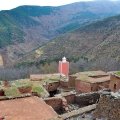Salam, fellow travelers! I’m Hassan, and if you’ve ever wandered through Amizmiz’s sunbaked streets, you’ve likely felt the whispers of history beneath your feet. This humble town isn’t just a gateway to the Atlas—it’s a living archive of Morocco’s past. From 16th-century scholars to Victorian adventurers, Amizmiz in history has been a crossroads of cultures, rebellions, and breathtaking landscapes. Let’s unravel its stories together.
Amizmiz’s Early Chronicles: From Leo Africanus to European Maps
Long before Instagram, the first “influencers” of Morocco were explorers like Leo Africanus. In 1550, he wrote of Amizmiz in history as a fertile plain near the Atlas, where snow-dusted peaks guarded ancient trade routes. His words painted a place of abundance—golden grain fields, bustling markets, and villagers fleeing political unrest.
Fast-forward to 1570, and Abraham Ortelius’s world atlas marked “Imizinizi” (a typo for Imizmizi) on maps—proof of Amizmiz’s role as a strategic stop for traders and travelers. By 1655, French cartographer Nicolas Sanson labeled it “Imizmiza,” a vital checkpoint before daring mountain crossings.
Why does this matter?
These maps weren’t just navigation tools—they put Amizmiz on the global radar. Imagine 19th-century British explorers clutching these very maps as they rode into town on exhausted horses!
The British Era: Tea, Tagines, and Turbulent Roads
John Davidson’s Misadventures (1836)
In 1836, British explorer John Davidson dubbed Amizmiz “Almishmish” in his journals. His tales? Flea bites, broken-nosed patients, and a Kaid (local leader) who gifted him a lavish garden breakfast. Davidson’s horse was so spent, he stayed an extra day—giving us some of the first gritty details of Amizmiz in history.
Joseph Hooker’s Botanical Quest (1871)
Hooker, a botanist pal of Charles Darwin, marveled at Amizmiz’s “spherical-headed Marrubium” flowers and terraced fields. He even tried bribing the local governor with a thermometer (rejected!) and a musical box (accepted!). His journals still guide plant lovers today.
Walter Harris’s Cliffside Escapades (1887)
Harris, part of a British diplomatic mission, nearly lost his breath riding narrow trails above the Amizmiz Valley. He described walnut groves, rivers “boiling like cauldrons,” and a ruined rose-pink Kasbah—a rebel-torn palace that still captivates visitors.
Landmarks That Tell Tales
The Kasbah Ruins
Once a grand palace, this mud-brick fortress was destroyed in the 1800s by townsfolk rebelling against a tyrannical Kaid. Today, its crumbling walls whisper of Berber resilience.
The Jewish Quarter (Mellah)
In the 1880s, Scottish explorer Joseph Thomson noted Amizmiz’s thriving Jewish community—uncommon in rural Morocco. Their “manly independence” and vibrant trade left a legacy still felt in the Mellah’s architecture.
The Amizmiz Valley
Hooker compared this valley to the Italian Alps, with walnut groves and terraced fields. Follow Thomson’s 1888 footsteps along the “Wad Amsmiz” river—it’s still a hiker’s paradise.
How to Walk Through History (Practical Tips)
- Visit the Kasbah: Wander the ruins at sunset. Picture Davidson’s flea-bitten nights or Harris’s cliffside dread.
- Hire a Local Guide: They’ll decode Berber place names and show hidden spots, like the rebel-dug tunnels.
- Pack a Journal: Retrace Hooker’s plant-hunting routes. Maybe you’ll find that spiky Marrubium!
- Respect the Layers: Ask before photographing elders—they might share oral histories you won’t find in books.
Pro Tip: Spring (March-May) brings wildflowers Hooker adored. Autumn (Sept-Nov) mirrors harvests Leo Africanus praised.
Why Amizmiz’s Past Matters Today
Standing in Amizmiz, I once met a potter whose family has shaped clay here since Thomson’s 1888 visit. “Our hands remember,” he said, spinning a bowl as his ancestors did. Amizmiz in history isn’t just dates and maps—it’s the heartbeat of generations who’ve farmed, rebelled, and welcomed wide-eyed strangers.
Ready to Write Your Own Chapter?
Amizmiz doesn’t shout its history—it hums it through almond groves and crumbling Kasbahs. Whether you’re tracing Victorian maps or sipping tea with a potter, you’re part of its story.
Have you visited a place where history felt alive? Share below—or ask me how to find Amizmiz’s rebel-carved tunnels!




